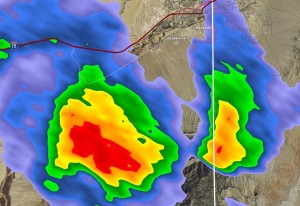
SOUTHERN UTAH — The National Weather Service has issued a “hazard weather outlook” for portions of Southern Utah, and a thunderstorm warning has also been issued for Clark County, Nevada, for storms hitting these locations Tuesday and continuing Wednesday.
Affected areas
Southern Utah
The hazardous weather outlook covers the western two-thirds of Utah as well as southwest Wyoming.

In Southern and southwest Utah, the weather outlook affects Utah’s Dixie, Zion National Park and Glen Canyon Recreation area/Lake Powell, as well as the central and southern mountains.
Scattered showers and isolated thunderstorms will continue to develop and move north-northeast over Southern and central Utah into the early evening hours Tuesday. The strongest storms, as of 5:40 p.m. MDT, were located over western Kane and western Millard counties. Some of these storms will produce heavy rain in local areas and will be accompanied by gusty winds and cloud-to-ground lightning.
Nevada
As of 3:22 p.m. MDT, thunderstorms were nearing Mesquite, Nevada, and Bunkerville, Nevada, with brief heavy rain, wind gusts of up to 50 mph, and lightning.
Seven-day outlook, Southern and southwest Utah
Day one: Tuesday and Tuesday Night
Moisture will continue to increase across the outlook area from the south Tuesday with showers and thunderstorms becoming more numerous. Local heavy rain is possible along with the threat of isolated flash flooding. The showers and thunderstorms will become more isolated Tuesday night.
Days two through seven: Wednesday through Monday
Showers and thunderstorms will increase in coverage again Wednesday across almost the entire outlook area. These storms will once again bring a threat of heavy rain and a heightened potential for flash flooding. A slow drying trend is expected to start on Thursday and will continue into the weekend, with storms becoming more isolated and less likely to produce heavy rain.
Spotter information statement
Weather spotters are encouraged to report significant weather conditions according to standard operating procedures.
Turn around. Don’t drown.
The National Oceanic and Atmospheric Association and the National Weather Service offer safety rules for flash flooding:
- Flash flooding is a very dangerous situation
- Flash flood waves, moving at incredible speeds, can roll boulders, tear out trees, destroy buildings and bridges and scour out new channels. Killing walls of water can reach heights of 10 to 20 feet. You will not always have warning that these deadly, sudden floods are coming. When a flash flood warning is issued for your area or the moment you first realize that a flash flood is imminent, act quickly to save yourself. You may have only seconds.
- Most flood deaths occur in automobiles. Do not drive your vehicle into areas where the water covers the roadway. Flood waters are usually deeper than they appear. The road bed may not be intact under the water. Just one foot of flowing water is powerful enough to sweep vehicles off the road. If the vehicle stalls, abandon it immediately and seek higher ground. Rapidly rising water may engulf the vehicle and its occupants and sweep them away
- Do not hike rivers and especially slot canyons while flash flood warnings are in place
- Do not hike alone and always tell someone where you and your buddy and others are going
- Get out of areas subject to flooding, including dips, low spots, canyons and washes
- Avoid already flooded and high velocity flow areas. Do not try to cross a flowing stream on foot where water is above your knees
- Be especially cautious at night when it is harder to recognize flood dangers
- Do not camp or park your vehicle along streams and washes, particularly during threatening conditions
During any flood emergency, stay tuned to your NOAA weather radio, commercial radio or television, follow St. George News at STGnews.com and St. George News Facebook for weather alerts and updates relevant to Southern Utah. Information from the National Weather Service and disaster and emergency services may save your life.
Related posts
- ‘Boulders the size of houses’; 34-mile road closure continues on Highway 89-A
- What to do before, during, after a flash flood
- I can’t believe I survived; video of flash flood crashing down on canyoneers
- St. George Library floods for 3rd time after heavy rains
- Storm swells Virgin River, flash flood at Fort Pierce Bridge; STGnews Aerial Videocast
- News LIVE: Storm hits Washington, homes flooded; STGnews Photo Gallery
Email: [email protected]
Twitter: @STGnews
Copyright St. George News, SaintGeorgeUtah.com LLC, 2015, all rights reserved.